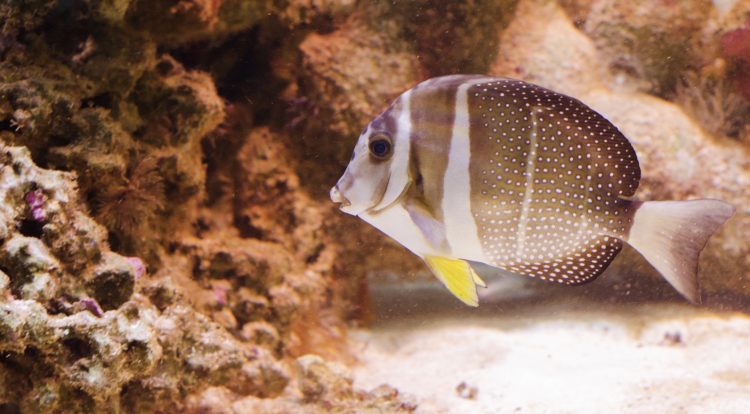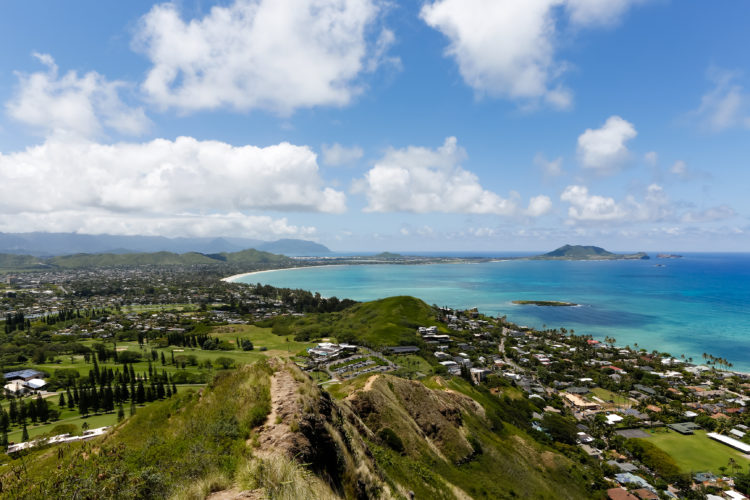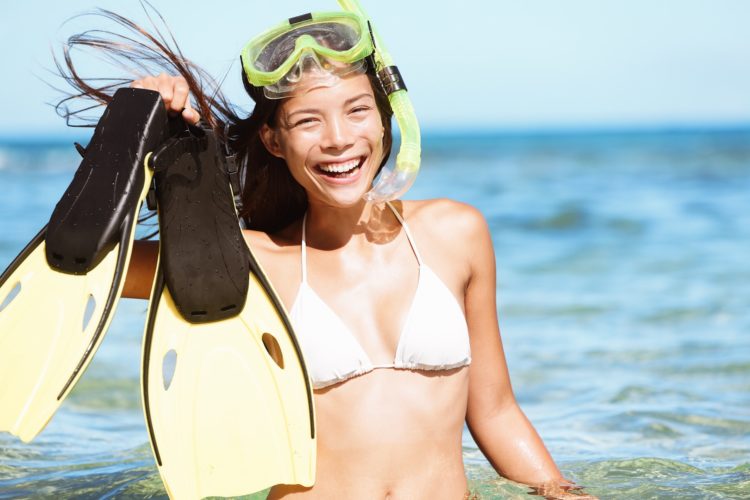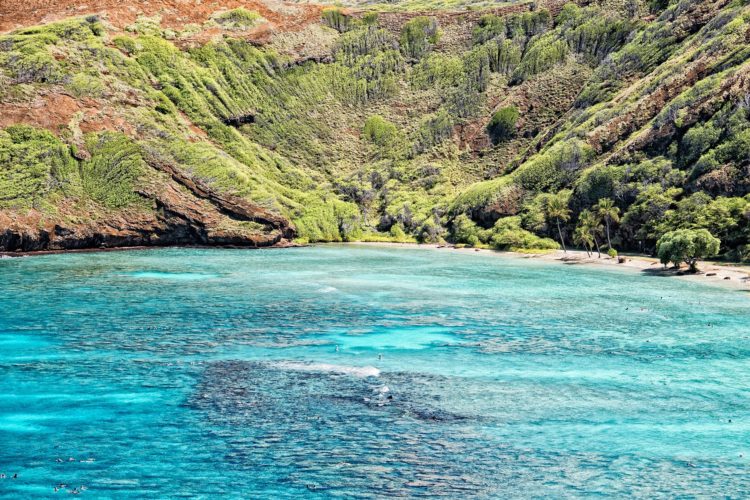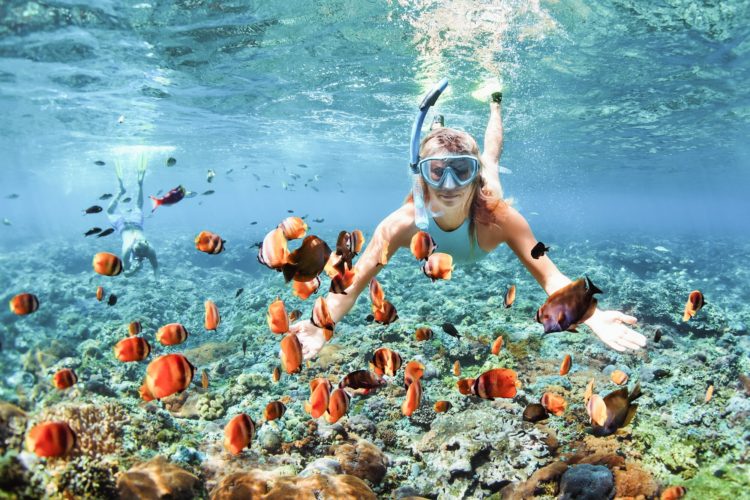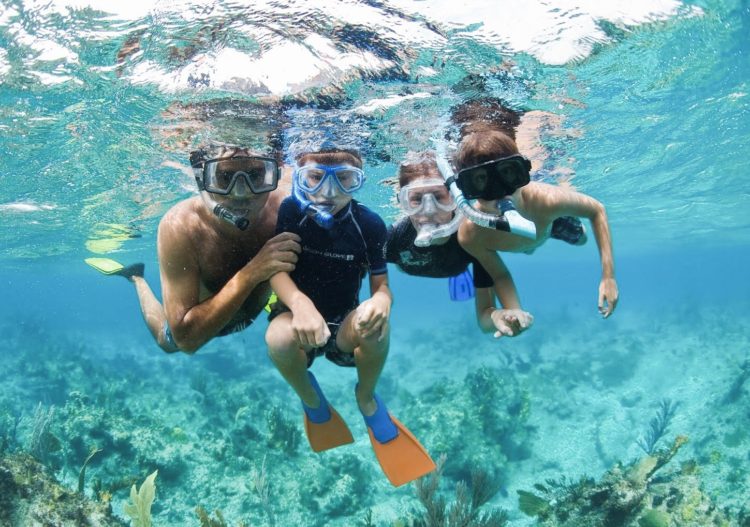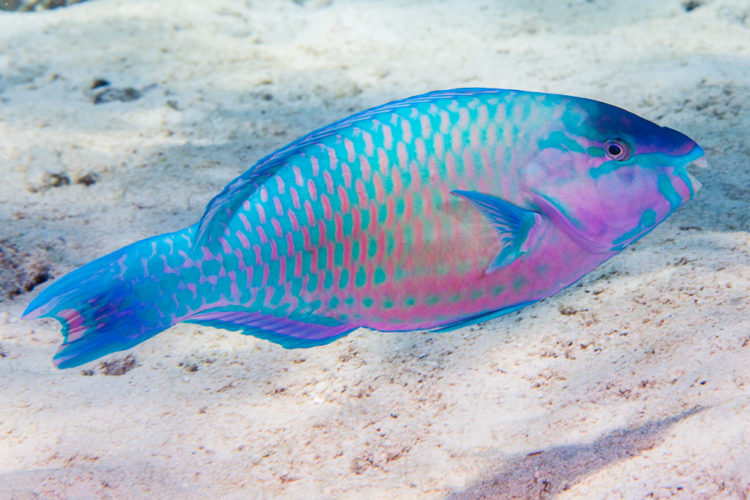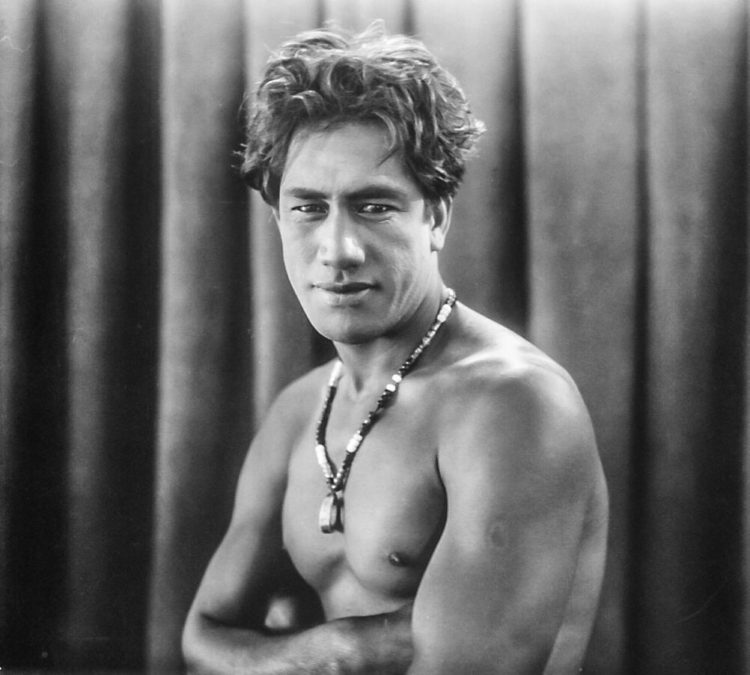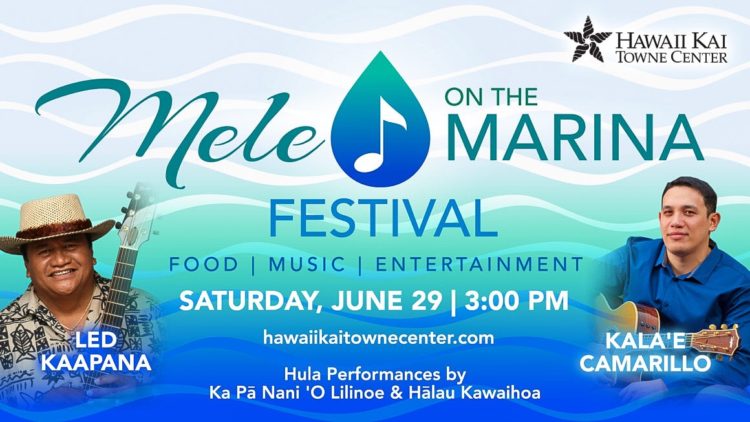The beauty of Hanauma and the residents that live within are the reasons we snorkel. We haven’t had a fish spotlight in a while, but this month we’re going back to the basics and highlighting one of our favorite Hanauma Bay locals – the surgeonfish!
When it comes to the worldwide surgeonfish population, there are over 80 different species, 25 of which live within Hawaiian waters. While these gorgeous fish are found in a variation of colors, they all have the same basic anatomy. They have two spines, one on each side of their bodies that normally lay flat in tight grooves. When the fish is provoked, or in a time of danger, it will flip its tail to reveal its spines that pop out like tiny knives. Those knives resemble a surgeons’ scalpel, therefore giving them the name “surgeonfish”.
Surgeonfish feed on algae and can usually be found near rocks that receive a lot of filter sunlight. You typically find them in shallow waters of the coral reef, grazing either in small groups or alone. You will rarely fine them in large schools.
Depending on their specific specie, they can grow to be as large as 22 inches, making them some of the easiest fish to spot in the bay. The largest surgeonfish found in the local area is the Yellowfin Surgeonfish. These fish will eat most types of algae available and average a length of 21 inches. They have a light tan body with yellow pectoral fins and markings around the eyes. While their size is substantial, they are more challenging to spot because of their light color and nominal markings.
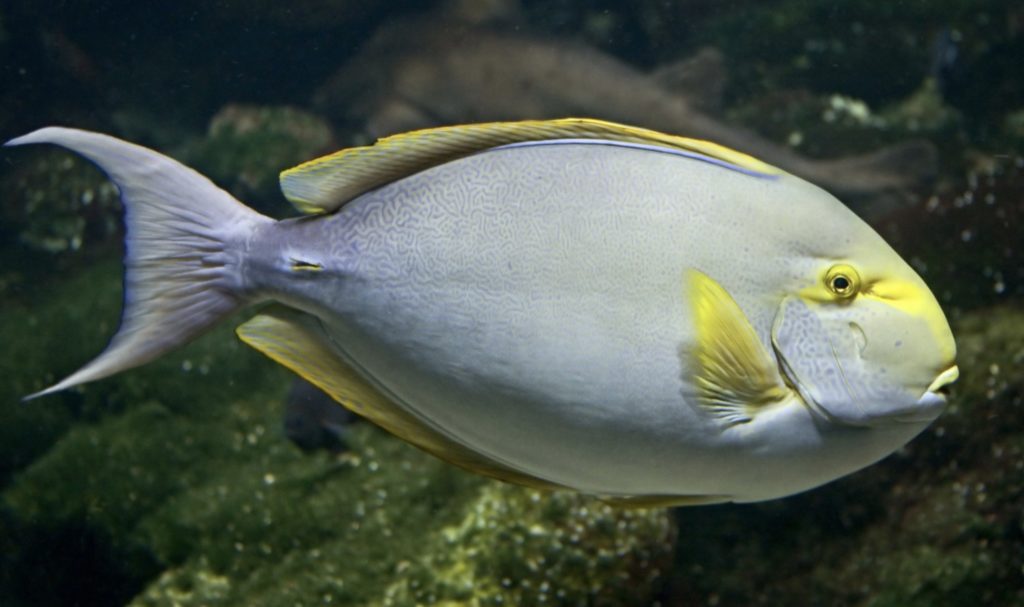
Another resident of the bay that may be a little easier to see is the Whitespotted Surgeonfish. As their name suggests, they are white and black with white spots that cover nearly two-thirds of their bodies. They are typically found where the surf is crashing, grazing on seaweed. Sometimes their spots act as a type of camouflage to resemble the surrounding bubbling water.It should be to no surprise that we are in love with Hanauma Bay and all that it has to offer. These are just a couple of the many varieties of surgeonfish that can be found at our favorite place in the world. We hope you all get the chance to experience the magic of Hawaii’s underwater paradise, and count on you to come to us to make it happen! Give us a call or book an excursion right here on the site. Aloha!
February is the month of love, and I think we can all agree that a tropical Hawaiian vacation is as romantic as they come. Let your significant other know how much she means to you with more than just a box of chocolates and bouquet of flowers. This month on the blog we’re letting you in on our top 3 most romantic hikes on the O’ahu.
Ka’iwa Ridge Trail (Lanikai Pillbox Trail)
Known for being a fairly easy trail, the view from Ka’iwa Ridge is among other things, spectacular. Along the trail one can see the Ko’olau mountains as well as Moku Iki, one of two small islands off the shore of Lanikai. Providing views of Kailua, the trail is most rewarding at dawn or dusk when the skies are clear, and the crowds are limited. For those who have ever wanted a romantic night stargazing, this hike offers a truly stellar experience of O’ahu’s night sky.
Likeke Falls
Sometimes also referred to as the Old Pali Highway Falls, Likeke is a gorgeous, two-tiered waterfall that can be found below the Pali Lookout. As the name may suggest, this spot involves getting a little wet! Please prepare accordingly. This trail is not meant for the novice hiker, but rather better suited for the adventurous couple willing to get a little dirty. The hour-long hike through lush forest and humid conditions will be made worth it once you get to the glistening falls and are able to commemorate the end of the trail with a kiss!
Makapu’u Point Lighthouse Trail
In search of an easy trail with quick access and sights of mother nature? Look no further. This 2-mile paved trail provides tremendous views of O’ahu’s east side from Kailua to Hawaii Kai. The final backdrop will surely set the romantic tone for you and your sweetheart.
No matter which hike you choose, grab some comfortable shoes, a reusable water bottle, and the spirit of adventure as you make your way to the romantic sights of the beautiful island of O’ahu.
Hawaii Kai Towne Center is back at it with a 96825 LIVE event. Another year has come and gone, and we’re ready to celebrate with our local community — join us and start 2020 off with a bang! Another HKTC event is headed towards us and we want to be sure you all are in the know.
On Friday January 31st bring the whole ohana to take pleasure in performances by Hawaii Kai Dance Academy, Ka Hale I O Kahala Hula School, and Halau Hula Ma Ka Pu’uwai A Ka Mana’o. Group performances will be held in the middle of the marina docks at 5, 6 and 7pm.
Don’t be shy! Grab some food from one of Hawaii Kai Towne Center’s many delicious eateries, pop up a couple of chairs and unearth what makes our community so special. This live event will bring out some of the community’s most talented artist, musicians, dance and school groups. This event is also both free and family-friendly. 96825 LIVE truly brings the best of Hawaii Kai to the heart of our community, and we hope to see you there.
From nationwide brands to local businesses, Hawaii Kai Towne Center is East Oahu’s leading retail destination and community gathering place, guaranteed to have something for the whole family.
Follow Hawaii Kai Towne Center on Facebook at www.facebook.com/HawaiiKaiTowneCenter and Instagram @hawaiikaitownecenter for more event listings and updates.
We are proud to be from Hawaii Kai, and are always up for supporting our home and it’s people. Know of any upcoming community events that you’d like us to be apart of? Let us know in the comments below. Looking to explore Hawaii Kai’s underwater community? Give us a call, we’ll set you up with some transportation and snorkel gear. Hanauma Bay is calling your name!
When considering snorkeling equipment, fins are usually not the first things that come to mind; however, here at Hanauma Bay Snorkel we highly recommend having a pair when exploring Hawaii’s underwater paradise. This month on the blog we’re dishing all things fin-related — keep reading to get the 411.
BENEFITS OF FINS
In most cases, fins make snorkeling easier and safer. Fins are meant to increase locomotion, and move you faster and smoother through the water. Spend less time swimming and more time exploring. They also act as a safety advantage, especially when ocean conditions turn less favorable — fins make it possible to return to a safe place quickly.
FINDING YOUR FIT
Snorkeling fins are generally flexible and light. Whether you choose adjustable or full-foot fins, both should fit snuggly without any pinching. No matter what style you decide on, we suggest giving it a quick shake test. Slip on both fins and, in all directions, shake your foot. Your fins should feel secure but not uncomfortable. If your feet feel pinched, try sizing up. Vice versa, if your fins move around when you shake your feet, size down and try the shake test again.
TECHNIQUE
Fins work their best when your kicks engage the entire leg. You should not be chopping through the water, but rather gliding. Be sure that your hips, thighs and glutes are doing most of the work, not your knees. Your body will also feel less aches and pains post-snorkel if you engage the proper muscles.
FIN ETIQUETTE
Many snorkelers tend to forget that fins add a substantial amount of length to your legs. Be aware of where you choose to stop to take a breather, adjust your gear or talk to a snorkel buddy. Chances are if you are in an upright position above any body of coral, your fins are slapping the reef. We suggest trying to stay as horizontal as possible when taking a quick snorkel break. If you have difficulty doing this, try using a flotation device (life vest, snorkel belt, etc.). Here at Hanauma Bay Snorkel we try our best to be good stewards of the reef.
Fins are designed to propel you through the water easier and quicker. And while snorkeling may always require energy, fins ensure that you expend that energy wisely. Our snorkel packages include transportation, gear and memories to last a lifetime. Give us a call today or schedule a session at the tab above.
The holidays are right around the corner, and we could not be any more excited for them. We have a lot to be grateful for here at Hanauma Bay Snorkel. We’ve got the most beautiful work place in the world and get to help others experience the magic of the bay too. We believe that snorkeling is an activity for the entire family, enjoyable for both young and old. Below are five snorkeling tips to keep your chance of accidents at a low, and your level of enjoyment at an all time high.
BE CONFIDENT
Learn to swim before heading on your snorkel adventure. Being comfortable in the water makes all the difference when snorkeling. The idea is to spend less time worrying about staying afloat and more energy towards enjoying the underwater paradise in front of you. We also believe that there should be no shame in wearing a safety vest — a safe snorkeler is a happy snorkeler.
FIND A BUDDY
We suggest finding someone with whom to snorkel. It’s always nice to have someone near by if you ever find yourself in a water emergency. Should you have to go out alone, stay close to shore. Find something on the beach to stay near to, preferably a lifeguard tower.
STAY HYDRATED
Snorkeling under the sun will quickly drain your energy, as well as your body’s storage of water. It’s always a good idea to load up on water before heading into the ocean. We also highly suggest bringing a large bottle of water to replenish anything lost while on your excursion.
SUN PROTECTION
Nothing ruins your vacation quite like a nasty sunburn. UV rays are no joke, and unfortunately many people skip the step of sun protection. You can purchase a protective rash guard for as little as $20 on Amazon, which is well worth the price, if sunscreen is not your thing. For those of you who prefer sunscreen, might we suggest using lotions that do not contain chemicals that will harm the coral reef or marine life.
LOOK DON’T TOUCH
Last but definitely not least, respect the ocean and its inhabitants. Try to remember that we are in their home. We ask that you neither touch the reef nor the creatures. While some animals prefer their privacy, others are flat out toxic. Contact with such animals could result in an emergency trip to the hospital. We hope you remember to keep a safe distance when in the ocean.
Snorkeling is a prime family activity that can be enjoyed by all — especially during this holiday season. We hope you keep these snorkeling safety tips in mind when heading out on your underwater excursion. Let us know if we can help you get your snorkel on.
For the most part, snorkeling is a very freeing activity for the whole family. Here at Hanauma Bay Snorkel Adventures we have some simple guidelines to guarantee a great time had by all. Keep reading for our short list of the do’s and don’t’s of snorkeling.
DON’T touch the coral. It may not look like it, but coral reef is a living organism that both houses and feeds thousands of underwater creatures. As snorkel enthusiasts and defenders of the bay, we ask that you try not to stand on or kick the reef.
DO use biodegradable sunscreen. Studies have shown that sunscreens with oxybenzone and octinoxate are harmful to the reef and can contribute to coral bleaching. In general, it’s safe to stay away from sunscreens with excess oil and harmful chemicals.
DON’T interfere with the marine life. We understand that the point of snorkeling is to observe Hawaii’s underwater paradise; however, we need to remember that observe does not mean interfere. Messing with the motion of the ocean could be hazardous to both you and the animals.
DO respect other snorkeler’s personal space. Snorkeling is a rush, it’s an opportunity to see marine life first hand; but most people do not want you grabbing their arm or pulling their leg to make sure they see the parrotfish that’s two feet away from you. Everyone snorkels at their own pace, and most people need to concentrate in order to be able to enjoy their snorkeling experience.
DON’T feed the fish. Feeding the marine life can throw off the natural flow of the bay. While sharing is usually caring, we advise otherwise when snorkeling — the fish have plenty of food.
DON’T take anything with you. Aside from the belongings you brought to the beach — all starfish, rocks, pieces of coral, fish, urchins and shells should remain where they were found.
While snorkeling is a family friendly activity, there are some DO’S AND DON’T’S that ensure an incredible experience. Here at Hanauma Bay Snorkel, we are all about making memories with the people you love. Go over these guidelines with your ohana, then head to the beach. We’ll be waiting for your call!
While summer may be at itʻs tail end, the fun in Hawaii truly never stops, and lucky for us snorkeling is a year-around activity perfect for the entire family. Some parents are quick to regard it as too advanced for keiki (children), but we’re here to prove otherwise. This month on the blog we’re dishing 3 ways children benefit from snorkeling.
- SNORKELING IS EDUCATIONAL
We’d argue that children will never receive a better lesson on marine life than taking a front row seat in the actual underwater environment. Snorkeling allows you to to observe the ocean in close range. On top of the close-up education, keiki become familiar with undersea etiquette. It’s vital for snorkelers, both adult and children, to understand that while the marine life may be within reach, one shouldn’t mess with the natural motion of the ocean. Snorkeling allows children to learn to keep their distance, and respect the ocean and its many residents. - SNORKELING IS HEALTHY
Snorkeling is great for strengthening heart muscle and increasing both blood circulation and heart rate — all factors that have proven to benefit cardiovascular health. Snorkeling has also been known to lower your risk of high blood pressure, heart disease and high cholesterol. We strongly believe that encouraging outdoor, physical activity — where a child is free to observe at his or her own free will — leads to a lasting healthy lifestyle. - SNORKELING DEVELOPS STRONGER SWIMMERS
Similarly to swimming, snorkeling requires you to use your entire body. While we do suggest wearing a life vest if you feel it necessary for your safety and enjoyment —floaty or not— snorkeling demands total body strength and loads of energy. As a business who cares deeply about families, snorkeling helps to strengthen and develop the same muscles your keiki use while swimming, and we consider that a massive win! Here at Hanauma Bay Snorkel safety comes first, and we believe that strong swimmers equal safe swimmers. In addition, snorkel gear eliminates the worry of not being able to breathe, and instead forces children to redirect that same energy to increase water awareness. Your body begins asking questions that focus on becoming a better swimmer— is the weight of my body evenly distributed? Am I kicking consistently? Is my body aligned?— rather than wondering when your next breath will come.
We hope this month’s blog post has convinced you that snorkeling is an activity for the entire ohana (family). Grab your keiki and head to the ocean, snorkels included. If Hanauma Bay is on your list of family snorkeling destinations, give us a call, we’d love to help you explore Hawaii’s underwater paradise.
Happy August everybody! The beauty of Hanauma Bay and the marine life that live in it are the whole reason we snorkel. This month on the blog weʻre going back to the basics with a spotlight on one of our favorite park residents— the parrotfish!
One of Hawaii’s most loved fish is in fact the parrot fish. Well known for their vibrant colors, you may also see them featured as entrees in popular meals of several restaurants in the state. Easily recognized by their unique mouth shapes, parrot fish have teeth protruding from their jaw, giving them a beak-like mouth resembling the tropical fowl that they’re named after.
Though they’re technically considered herbivores, parrotfish can be found in Hanauma Bay with diverse diets including many polyps found on the reef. Utilizing their beaks, parrotfish easily collect the organisms from the reef’s rock-like surface.
Like many species of fish the parrotfish travel in schools of varying sizes (7” to 24”). They are diurnal creatures that spend their days eating off the coral and then sleep in the security of the small cracks and crevices formed between the reef and rocks. Some parrot fish can be found secreting a mucus to deter any would-be predators.
In Hawaii you may find seven different types of parrotfish roaming the waters— stareye, yellowbar, spectacled, bullet head, regal, pale nose, and redlip.

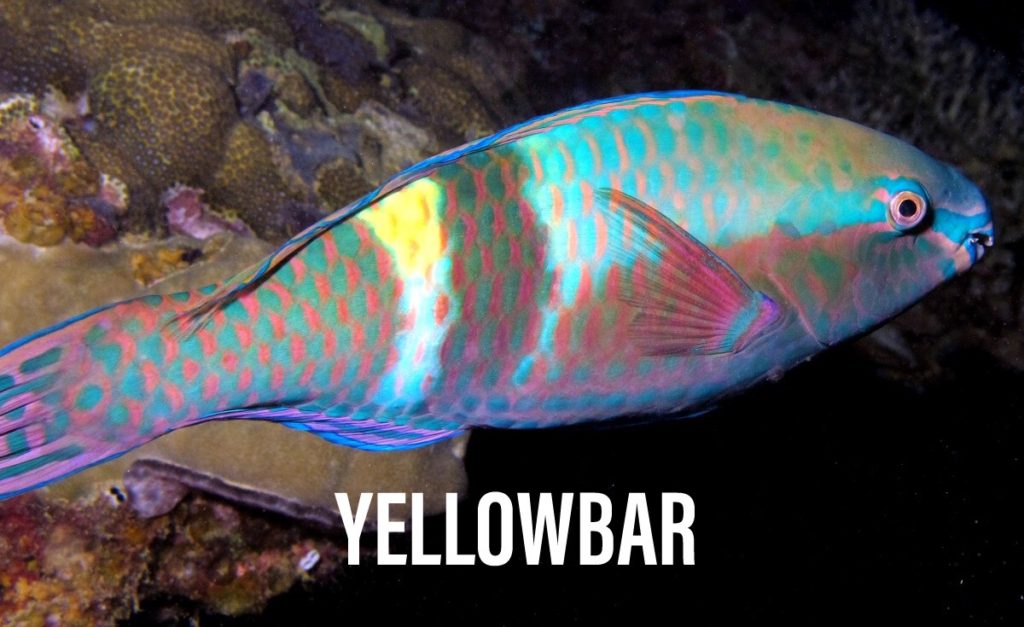
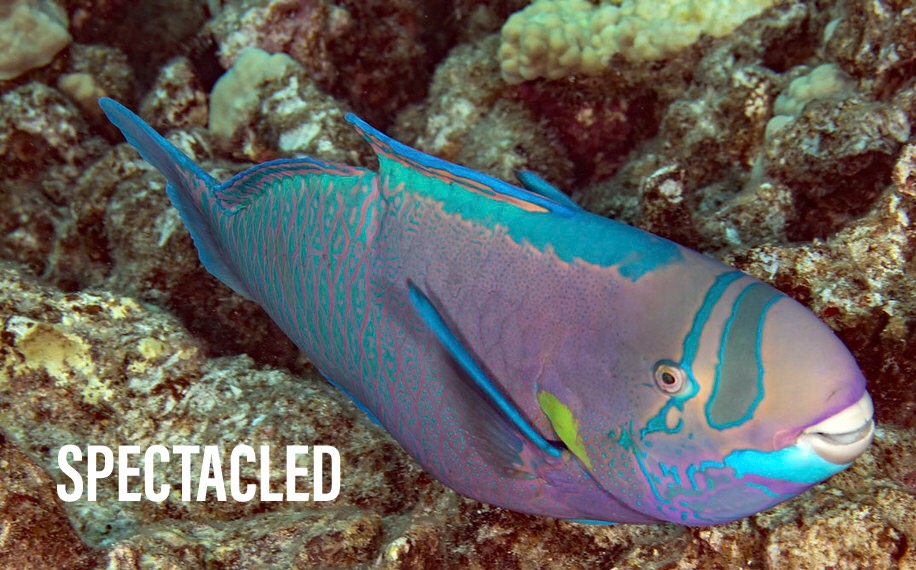
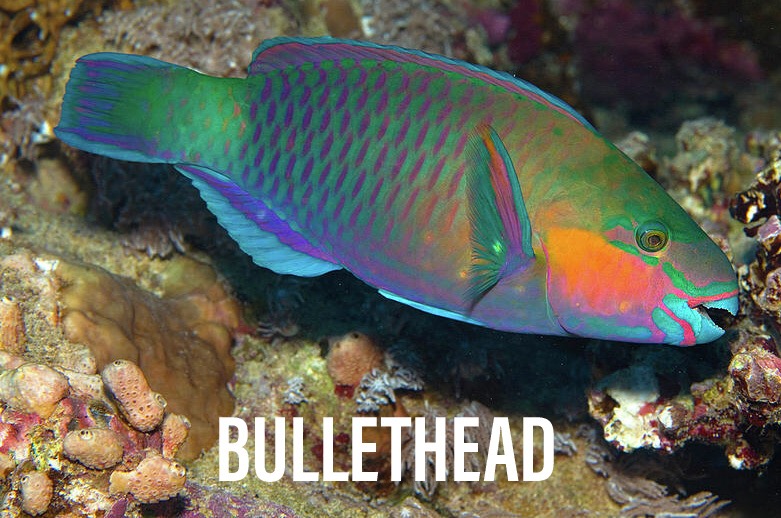
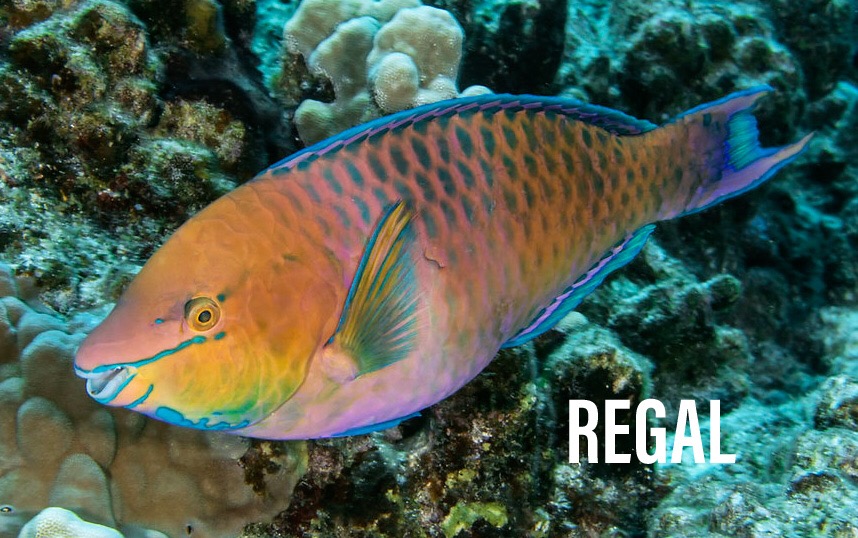
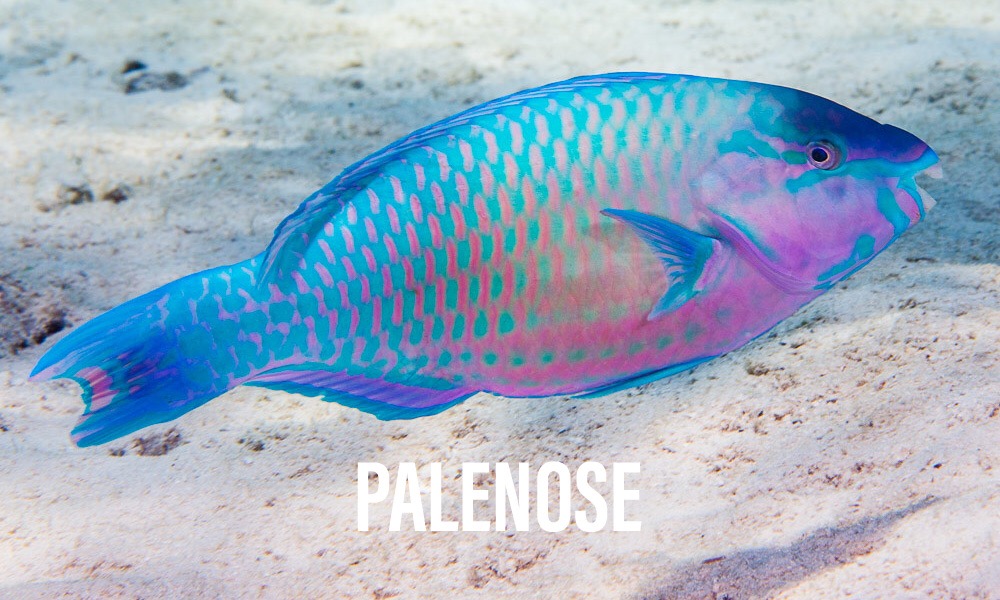
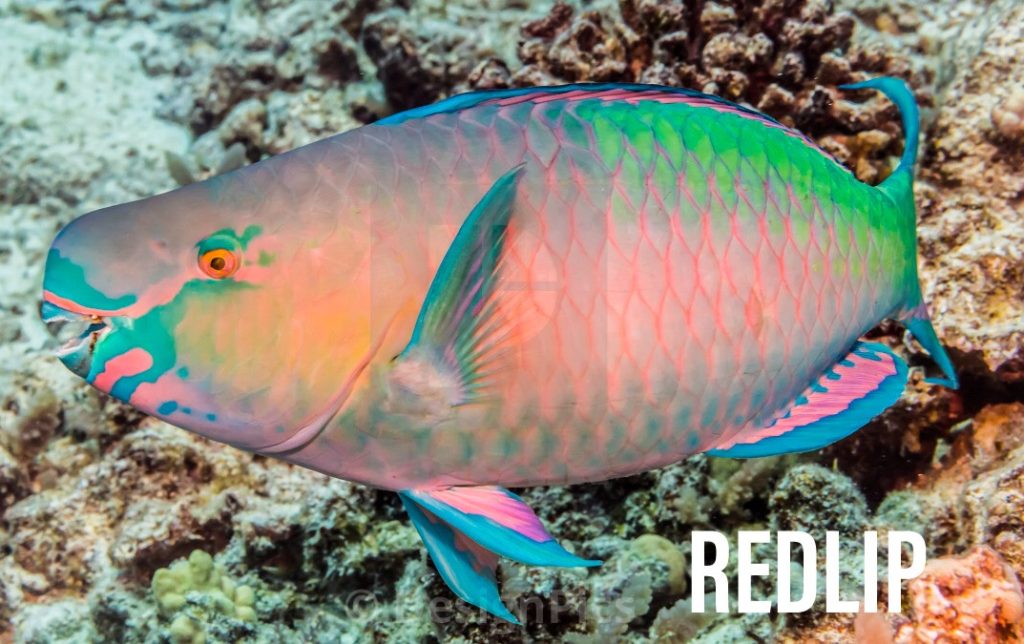
It’s safe to say we are obsessed with the bay and all of the beauty it has to offer. We absolutely love being able to call Hawaii home and Hanauma Bay work (though it feels more like play!). We find it essential that everyone experience the underwater magic at least once in their lifetime, and hope you’ll come to us to make it happen. Book yourself a snorkeling excursion right here on the website, or give us a call to learn more about our services. Aloha!
Duke Kahanamoku was more than just the first native Hawaiian to bring he’enalu (surfing) to the United States mainland — he was the first native Hawaiian to swim competitively at an international level and will forever be Hawaii’s first Ambassador of Aloha. This month we’re shedding light on another Hawaiian Hero.
Duke Paoa Kahinu Mokoe Hulikohola Kahanamoku was born on August 24, 1890 at the home of Bernice Pauahi Bishop in Honolulu. His parents, Duke Halapu Kahanamoku and Julia Pa’akonia Paoa, were lower-level nobles whose duty was to serve the monarchy. His family moved to Kālia, Waikiki three years after he was born to be closer to extended family. Duke ended up being raised alongside his three sisters, five brothers and thirty-one Paoa cousins with the Pacific Ocean as their backyard. Little Duke attended Waikiki Grammar, Kaahumanu and Kamehameha schools before dropping out of school early to help financially support his family.
Duke’s obsession with the ocean began at a very early age. As a young child, he would swim in search of silver coins through shark-infested waters at the Honolulu Harbor. He also devoted a lot of time to Waikiki beach perfecting his swim strokes and surfing skills. His swimming abilities continued to blossom, and at the raw age of twenty-two Duke earned a spot on his first American Olympic Swimming team. He would be the first-ever native Hawaiian to compete at such a level. Duke won his first gold medal in the 100-meter freestyle and a first silver medal with the 4×200-meter U.S. men’s freestyle relay team in the 1912 Summer Olympics in Stockholm. He also won gold medals in the 1920 Antwerp Olympics and silver medals in the 1924 Paris Olympics (alongside fellow Hawaiians Pua Kealoha and Samuel Kahanamoku).
Mainland sportswriters quickly took notice of Kahanamoku’s athletic abilities and noticeably positive demeanor, and nicknamed him “The Duke.” He decided that he would then use his athletic notoriety to bring Hawaii and its aloha-based culture into the national spotlight. Duke is best remembered for introducing the ancient Hawaiian art of surfing — a sport unheard of outside of the islands — to the United States mainland. While Duke was a swimming champion, his true passion was always surfing.
He would provide surfing demonstrations on his 16-foot koa wood, finless surfboard to both the east and west coast of the United States with the hopes of bringing popularity to the activity. In his autobiography, Duke says that surfing “leaves you rewarded with a feeling of freedom and independence while rocketing across the face of a wave.” While Duke Kahanamoku never reached his goal of making surfing an Olympic event in his lifetime, he did popularize the sport enough to have it become an important and regular part of everyday American life. Films like “Beach Blanket Bingo”, “Gidget” and musics groups like The Beach Boys were all made possible because of Duke’s cultural contribution.
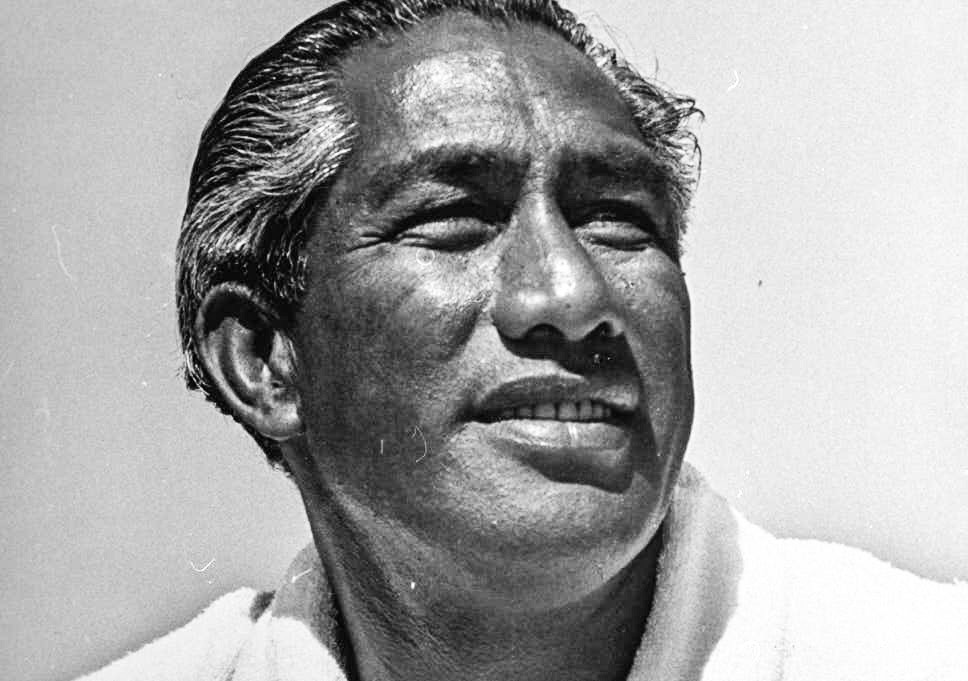
While Duke was never dominated by fortune or fame, he was a natural born businessman and lent his name for a generous profit to Hawaiian and American surfing teams, gear and competition. King Kamehameha, the native Hawaiian king responsible for uniting all eight Hawaiian Islands, prophesied that “before the native Hawaiian race died out, one man would bring it fame”. Most natives believe that Duke Kahanamoku fulfilled that prophecy. Since his passing in 1968, Duke was named Surfer of the Century by Surfer Magazine.
Throughout his life Duke Kahanamoku was beloved for his sportsmanship, humble attitude, positivity and amazing skill in the water. Next year in the 2020 Tokyo Olympics, surfing will make its debut as an olympic sport. We can’t help but feel emotional knowing that one native Hawaiian’s seemingly tiny cultural contribution will soon be recognized by the entire world. Today Duke Kahanamoku remains a legendary waterman, remembered by all, and an inspiration to live life with aloha.
Here at Hanauma Bay Snorkel we strive to live and share aloha, like Duke, every day. We hope that our snorkeling tours bring you memories to last a life time and leave you feeling #luckytovisithawaii.
When Hawaii Kai puts on an event that we plan to attend, we can’t help but share it with our Hanauma Bay ‘ohana. We love our community and those that make it such a special place to live. There’s a certain kind of pride that comes with living in HK, and this month we’re here to spread a little of that aloha to you!
First things first, Farmer’s Market season is fully-fledged and we think it’d be selfish to keep Hawaii Kai Towne Center’s to ourselves. Stop by the Marina Courtyard every Wednesday and Saturday, beginning at 7:30a for some local produce and goods.
In addition to the Farmer’s Market twice a week, be sure to mark your calendars for Saturday, June 29th. Mele on the Marina returns to the HKTC stage with a bang. Bring the entire family and a few foldable chairs to this free event. The magic begins at 3pm with hula performances by Ka Pā Nani ‘O Lilinoe, followed by Hālau Kawaihoa at 4pm. The Hawaiian entertainment doesnʻt stop there — catch local boy, singer/songwriter Kalaʻe Camarillo on at 5pm and Nā Hōkū Hanohano award winner Led Kaapana at 6pm. The master slack key guitarist and Grammy award nominee, best known for his unique voice and layback local style, will close the night with a Hawaiian-style performance that will surely leave you in awe and inspired. There’s a reason he entertains all over the world!
While we consider ourselves the masters of Hanauma Bay snorkeling, Hawaii Kai Towne Center is East Oahu’s number one spot for retail and dining, and is known as the all-around community gathering place. We spend quite a bit of time there and love that Mele on the Marina allows us to shop, eat and witness a little bit of aloha all in one place! Follow Hawaii Kai Towne Center on Facebook at www.facebook.com/HawaiiKaiTowneCenter and Instagram @hawaiikaitownecenter for more event listings, special promos and updates.
Know of any other upcoming community events? Shoot us a comment below, we’re honored to call Hawaii Kai home and are always up to support local.

